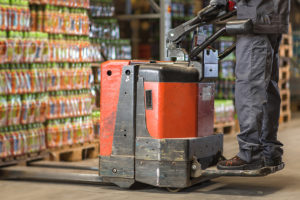July 8, 2020
Safe lifting techniques for preventing injury
In the workplace, back injuries are one of the most common injuries and one of the most debilitating. But they can also be easily avoided using safe lifting techniques such as proper methods of body mechanics and material handling.
Knowing the right technique for safe lifting is essential for preventing injuries. Remember to lift from a position of power by following these four steps:
- Keep your head up
Keep your eyes and chin up. Face forward and keep your eyes parallel to the floor. Using this position helps maintain a neutral curve in your back while lifting.
- Keep the load close
The closer the load is to your body, the better. Holding the load away from your body can increase the chance for strains and sprains to the shoulders, arms and back.
- Use a staggered stance
While lifting, place feet shoulder width apart with one foot slightly back and turned outward to improve your balance. This will provide improved foot placement for quick reactions, a more stable lift, and decrease the risk of a back strain.
- Nose follows toes
Avoid twisting by keeping your feet and head aligned. Use your feet to change direction, making sure to keep your entire body in line as you do so.
Safe lifting techniques
If you can, find ways to avoid manual, physical lifting. When available, use mechanical lifts such as lifting tables, powered pallet jacks, forklifts and overhead lifting systems. Look for opportunities to integrate conveyor systems. Alternatively, try pushing or rolling instead of lifting, if possible.
When lifting is necessary, take measures to make the lift as easy as possible. Don’t store materials on the floor or where you’ll have to reach high to lift them. Instead, store them at heights between the knees and shoulders, especially if they are heavy. Find ways to reduce the carrying distance and decrease the duration of the lift.
Other lifting recommendations include:
- Get your body warmed up and stretch prior to the lift.
- When lifting, keep your back straight and use the knees and legs to take most of the load. Don’t bend at the waist.
- Know how much the item weighs prior to lifting to avoid an unexpected strain.
- Plan your route and make sure the path is clear.
- Ask another employee for help when lifting heavy loads. The NIOSH limit for lifting is 35 pounds per person under ideal circumstances before team lifting or mechanical lifting devices are recommended.
- Communicate with the people around you. Let them know where you are and where you’re going in order to avoid accidents.
Safe patient handling
Within a health care setting, there are a few more things to keep in mind when lifting patients or residents.
Always use mechanical assist devices whenever indicated by the care plan. Devices should be readily accessible and kept in good condition. Examples include sit-to-stand lifts, friction reducers and slide boards, walkers and shower chairs, trapeze bars and safety rails. If you don’t know how to use this equipment ask your supervisors for instruction and assistance.
When feasible, ask the patient to help you as much as possible and communicate with them about what you are going to do. If you need assistance, get help from a coworker.
Using these safe lifting techniques will not only help you avoid painful back injuries, but it's also more comfortable and less invasive for your patients.
Lifting resources
- “Plan your lift” handout
- A supervisor’s role in preventing back injuries
- Safe patient handling 5-Minute Solution
See the full list of SFM's lifting resources.





